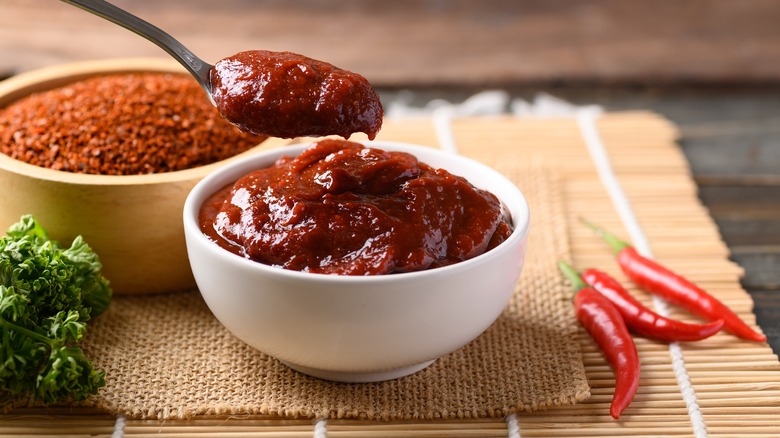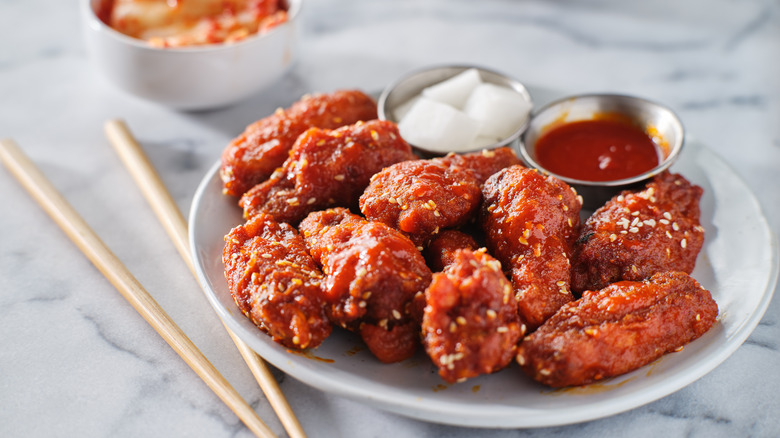The Spicy Ingredient Bobby Flay Reaches For When Making A Steak Glaze
Bobby Flay is well-known for his love of spicy ingredients, and often likes to put his own chili-infused spin on dishes. The chef is also famous for his love of steak and grilling, and while Flay's favorite barbecue sauce is a hot variety made with cayenne pepper, he uses a different spicy ingredient on steaks at his newest restaurant, Brasserie B in Las Vegas.
Inspired by Parisian brasseries, the spot located in Caesars Palace, Las Vegas features several classic French-style dishes, from duck confit to filet mignon. But there are some signature Flay touches, too: Mussels come in a harissa broth, while the skate is garnished with a smoked chili butter. As for the ribeye steak option on the menu, Flay has chosen to use the fermented chili paste gochujang to really ramp up the flavor.
In an exclusive interview with Tasting Table, Flay described the punchy Korean condiment as "literally one of the best ingredients in the world." The red paste, which also contains fermented soybeans, glutinous rice, salt, and sweeteners, takes the spicy flavors in Flay's steak dish to the next level.
Bobby Flay uses gochujang for a sweet and spicy glaze
While often used in dipping sauces and marinades, Bobby Flay perfectly cooks a juicy steak and then uses gochujang to make a glossy glaze at Brasserie B. The robustly-flavored, umami-rich paste is just one layer of heat added to the ribeye, which is first coated in a spice rub before being grilled. The glaze covers the cooked beef with another level of flavor, and the beef is finished with an earthy chili butter.
Spicy like sriracha and savory like miso, gochujang also has a subtle sweetness, giving it a complex and rounded flavor. All of these elements work exceptionally well with rich, fatty ribeye steak and other grilled meats; there's a reason you'll often find this condiment at Korean barbecue joints. Flay says his glaze "[has] got spice to it, it's got sweetness to it, and it has that fermentation to it".
The "Beat Bobby Flay" star also tells Tasting Table that gochujang steak is "something that I like to make myself during the summer, grilling outside." And while it pairs perfectly with beef, such as in a Korean steak frites recipe, the paste can be used to imbue all kinds of meat, fish, and vegetable dishes with an intense injection of flavor.
Use the spicy ingredient to elevate a variety of dishes
The trick to a better rice bowl is aggressively seasoned toppings, and gochujang can help to get you there. In bibimbap, the Korean dish of rice, meat, veggies, eggs, and other ingredients, gochujang creates a perfect balance of sweet, sour, hot, bitter, and salty flavors. Red meat lovers could also marinate strips of steak in the spicy paste mixed with honey, soy, and rice vinegar, then stir-fry. The meat is perfect when served with bouncy noodles and colorful, crunchy veggies.
This condiment works beautifully with chicken, too. Korean fried chicken is often tossed in a hot, sticky gochujang glaze. You can also marinate chicken in the paste before grilling; Bobby Flay is a fan, describing the ingredient as his "secret weapon" (via Facebook). On the porky side, try marinating cubes of juicy pork belly with gochujang before grilling it on skewers. You could even mix the spicy paste with maple syrup to glaze bacon for a flavorful brunch dish served with fluffy pancakes.
Fish and vegetables can also be given the sweet-spicy treatment. Add gochujang to a seafood broth for a welcome kick, or use it to glaze salmon. Try it as a dipping sauce for crispy cauliflower florets, or mix gochujang with vegetable oil, sesame seeds, soy, and lime juice to coat root vegetables before roasting. Side dishes don't get much tastier than this.
Static Media owns and operates Tasting Table and Food Republic.



